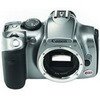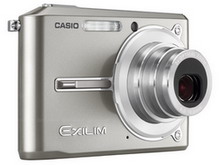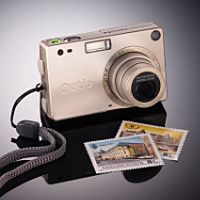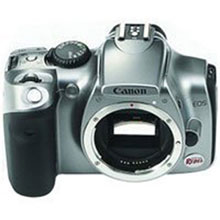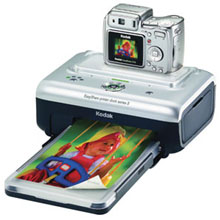Nikon D200 Digital SLR Camera - Black Finish - D200BODY
Nikon D200 Digital SLR Camera - D200BODY/ Body Only/ 10.2 Megapixel/ Large Viewfinder With 0.94x Magnification/ Durable Magnesium Alloy Body/ 5fps High-Speed Continuous Shooting/ 2.5" LCD Monitor/ Built-In Speedlight
Key features:
* 10.2 Megapixel DX Format CCD Image Sensor
A newly developed 10.2 effective megapixel DX Format CCD image sensor that captures images with edge-to-edge sharpness and incredible color at 3,872 x 2,592 pixels, yielding extraordinarily high-resolution images perfect for enlargements or creative cropping
* Industry-Leading Image Processing For Exceptional Color Performance
Incorporates Nikon's industry-leading advanced imaging processing engine of the D2x, which allows color-independent pre-conditioning prior to A/D conversion to work in symphony with advanced digital image processing algorithms to achieve fine color gradations with exceptionally smooth, consistent transitions
* Large Viewfinder With 0.94x Magnification
The new eye-level optical viewfinder developed for the D200 features large magnification (0.94x) that helps ensure a clear view for precise composition, and built-in diopter adjustment that allows fine-tuning to your eyesight
* Durable, Magnesium Alloy (Mg) Body
Nikon's advanced technologies and mechanisms are housed within a rugged, lightweight magnesium alloy chassis and body ready for the most rigorous of assignments. Additional sealing for dust and moisture add to the D200's strength.
* 5fps High-Speed Continuous Shooting
Capture fast action and fleeting expressions with the ability to capture high-resolution images at a rapid 5 frames per second in continuous bursts of up to 22 NEF (RAW) or 37 JPEG (FINE - LARGE) shots**
* Fast SLR Response Where It Counts
Instant power-up in just 0.15 seconds, a shutter release time lag of a mere 50 milliseconds, and a shortened viewfinder blackout time of just 105 milliseconds makes the D200 ready to respond to any photographic situation
* New, 11-Area Multi-CAM AF System With 7 Area Wide AF
The new Multi-CAM 1000 AF Sensor Module offers an 11-area AF that ensures consistently fast and precise focus lock under varying shooting conditions. The 7-wide area AF system, offers broad coverage suited for moving subjects enabling greater compositional freedom
* Large 2.5" LCD Monitor With Wide Angle Viewing To 170 Degrees
A high-resolution LCD monitor provides ultra-wide, 170 degree viewing in all directions. Assisting with accurate sharpness assessment, images can be previewed at up to 400% magnification
* New EN-EL3e Rechargeable Battery With Fuel Gauge Function
The high-energy EN-EL3e rechargeable lithium-ion battery lets you capture approximately 1,800 shots per charge featuring an accurate real-time Fuel gauge system that displays the percentage of remaining charge, number of shots since last charge and overall status of battery service life
* Wireless Transmitter WT-3
The optional Wireless Transmitter WT-3 provides wireless functionality with IEEE 802.11b/g technology; it enables cable-free image transfer to a compatible computer, with the added safety and versatility of wide-ranging network and security protocols (Available 2006)
Specifications:
* Type Of Camera: Single-lens reflex digital camera
* Effective Pixels: 10.2 million
* Image Sensor: RGB CCD, 23.6 x 15.8mm; total pixels: 10.92 million
* Image Size (Pixels): 3,872 x 2,592 [L], 2,896 x 1,944 [M], 1,936 x 1,296 [S]
* Storage Media: CompactFlash(TM) (CF) Card (Type I and II ) and Microdrive(TM)
* Sensitivity: 100 to 1600 (ISO equivalent) in steps of 1/3, 1/2 or 1 EV with additional settings up to 1 EV over 1600
* File System: Exif 2.21, Compliant DCF 2.0 and DPOF
* Storage System: Compressed or uncompressed NEF (RAW): 12-bit compression, JPEG: JPEG baseline-compliant
* White Balance: Auto (TTL white balance with 1,005-pixel RGB sensor), six manual modes with fine-tuning, color temperature setting, preset white balance, white balance bracketing possible (2 to 9 frames in increments of 1, 2 or 3)
* LCD Monitor: 2.5-in., 230,000-dot, low-temperature polysilicon TFT LCD with brightness adjustment
* Playback Function: Full frame 2) Thumbnail (4 or 9 segments) 3) Zoom 4) Slideshow 5) RGB histogram indication 6) Shooting data 7) Highlight point display 8) Auto image rotation
* Interface: Can be selected from NTSC and PAL
* Picture Angle: 35mm [135] format is approx. 1.5 times lens focal length
* Text Input: Up to 36 characters of alphanumeric text input available with LCD monitor and multi-selector; stored in Exif header
* Compatible Lenses: All AF-DX, AF-D, AF-G, AF-I, AF-S, and AF VR Nikkor lenses provide full AF and metering operation. AI-P lenses provide manual focus w/ electronic rangefinder and full metering operation. AI lenses provide manual focus w/ electronic rangefinder, Aperture Priority and Manual exposure mode, C/W and Spot metering operation.
* Viewfinder: Fixed eye-level Pentaprism type; built-in diopter adjustment (-2.0 to +1.0m-1)
* Eyepoint: 19.5mm (-1.0m-1)
* Focusing Screen: Type-B BriteView Clear Matte screen Mark II with superimposed focus brackets and On-Demand grid lines
* Viewfinder Frame Coverage: Approx. 95% (vertical and horizontal)
* Viewfinder Magnification: Approx. 0.94x with 50mm lens at infinity; -1.0m-1
* Viewfinder Information: Focus indications, Metering system, AE/FV lock indicator, Flash sync indicator, Shutter speed, Aperture value, Exposure/Exposure compensation indicator, ISO sensitivity, Exposure mode, Flash output level compensation, Exposure compensation, Number of remaining exposures
* Autofocus: TTL phase detection by Nikon Multi-CAM 1000 autofocus module with AF-assist illuminator (approx. 0.5m to 3.0m)
* Lens Servo: Instant single-servo AF (S); continuous-servo AF (C); manual (M); predictive focus tracking automatically activated according to subject status in continuous-servo AF
* Focus Area: Normal: 11 areas; single area or group can be selected; Wide: focus area can be selected from 7 areas
* AF Area Mode: 1) Single Area AF 2) Dynamic Area AF 3) Group Dynamic 4) Dynamic area AF with closest subject priority
* Focus Lock: Focus can be locked by pressing shutter-release button halfway (single-servo AF) or by pressing AE-L/AF-L button
* Exposure Metering System: Three-mode through-the-lens (TTL) exposure metering. 1) 3D Color Matrix Metering II (type G and D lenses); color matrix metering II (other CPU lenses); color matrix metering available with non-CPU lenses if user provides lens data; metering performed by 1,005-segment RGB sensor. 2) Center-weighted: Weight of 75% given to 6, 8, 10, or 13mm dia. circle in center of frame. 3) Spot: Meters 3mm dia. circle (about 2.0% of frame) centered on active focus area (on center focus area when non-CPU lens is used).
* Exposure Metering Range: (ISO 100, f/1.4 lens, 68 degrees F): 1) EV 0 to 20 (3D Color Matrix or center-weighted metering)2) EV 2 to 20 (spot metering) (ISO 100 equivalent, f/1.4 lens, 20°C)
* Exposure Meter Coupling: Combined CPU and AI
* Exposure Modes: Programmed Auto [P] with flexible program; Shutter-Priority Auto [S]; Aperture Priority Auto [A]; Manual [M]
* Exposure Compensation: Plus or minus 5 EV in increments of 1/3, 1/2 or 1 EV
* Auto Exposure Lock: Luminosity locked at detected value with AE-L/AF-L button
* Auto Exposure Bracketing: 2 to 9 exposures in increments of 1, 2, or 3
* Shooting Modes: 1) Single frame shooting mode 2) Continuous low speed (CL) shooting mode: 1 to 4 frames per second 3) Continuous high-speed shooting mode: 5 frames per second 4) Self-timer shooting mode 5) Mirror-up mode
* Shutter: Electronically-controlled vertical-travel focal plane shutter, 30 to 1/8,000 sec. in steps of 1/3, 1/2 or 1 EV, bulb
* Sync Contact: X-contact only; flash synchronization at up to 1/250 sec.
* Flash Control: 1) TTL: TTL flash control by 1,005-pixel RGB sensor; Built-in Speedlight: i-TTL balanced fill-flash or standard i-TTL flash (spot metering or mode dial set to [M]) SB-800 or 600: i-TTL balanced fill-flash for digital SLR and standard i-TTL flash for digital SLR. 2) Auto aperture: Available with SB-800 with CPU lens. 3) Non-TTL Auto: Available with Speedlights such as SB-800, 80DX, 28DX, 28, 27, and 22. 4) Range-priority manual; available with SB-800
* Flash Sync Mode: 1) Front-curtain Sync (normal sync), 2) Red-eye Reduction, 3) Red-eye Reduction with Slow Sync, 4) Slow Sync, 5) Rear-curtain Sync
* Built-In Speedlight: Manual pop-up with button release Guide number (ISO 100, m): approx. 12 (manual 13)
* Flash Compensation: -3 to +1 EV in increments of 1/3 or 1/2 EV
* Accessory Shoe: Standard ISO hot-shoe contact with safety lock provided
* Sync Terminal: ISO 519 standard terminal
* Self-Timer: Electronically controlled timer with 2 to 20 seconds duration
* Depth Of Field Preview: When CPU lens is attached, lens aperture can be stopped down to value selected by user (A and M mode) or value selected by camera (P and S mode)
* Remote Control: Via 10-pin Remote Cord MC-22/30/36 (optional) or Wireless Remote Control WT-3 (optional)
* GPS: NMEA 0183 (Ver. 2.01) interface standard supported with 9-pin D-sub cable (optional) and GPS Cable MC-35 (optional)
* Power Source: One Rechargeable Li-ion Battery EN-EL3e, MB-D200 battery pack (optional) with one or two rechargeable Nikon EN-EL3e Li-ion batteries or six AA alkaline (LR6), NiMH (HR6), lithium (FR6) batteries, or 2R6 nickel-manganese AA batteries, AC Adapter EH-6 (optional)
* Tripod Socket: 1/4 in. (ISO)
Supplied Accessories:
* Rechargeable Li-ion Battery EN-EL3e
* Quick Charger MH-18a
* Video Cable
* USB Cable UC-E4
* Strap
* Body cap
* Eyepiece Cap DK-5
* Rubber Eyecup DK-21M
* LCD monitor cover BM-6
* PictureProject CD-ROM
Approximate Dimensions:
* Width: 5.8"
* Height: 4.4"
* Depth: 2.9"
Approximate Weight:
* Unit (Without Battery, Memory Card, Body Cap, Or Monitor Cover): 1lb 8 oz
* Shipping: 5 lbs
More digital camera visit and make donation click at http://new-best-camera-digital-review-cheap.blogspot.com



